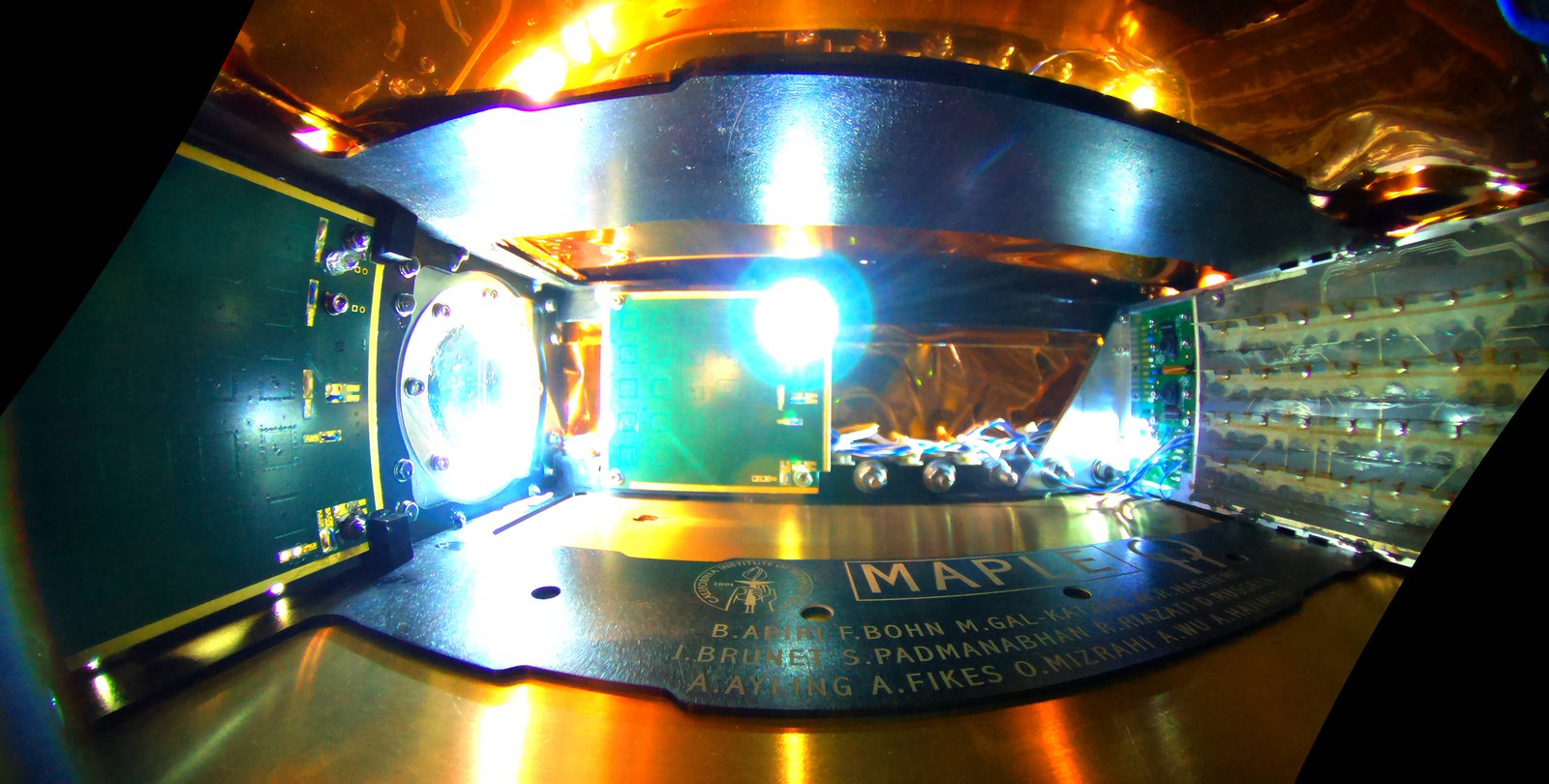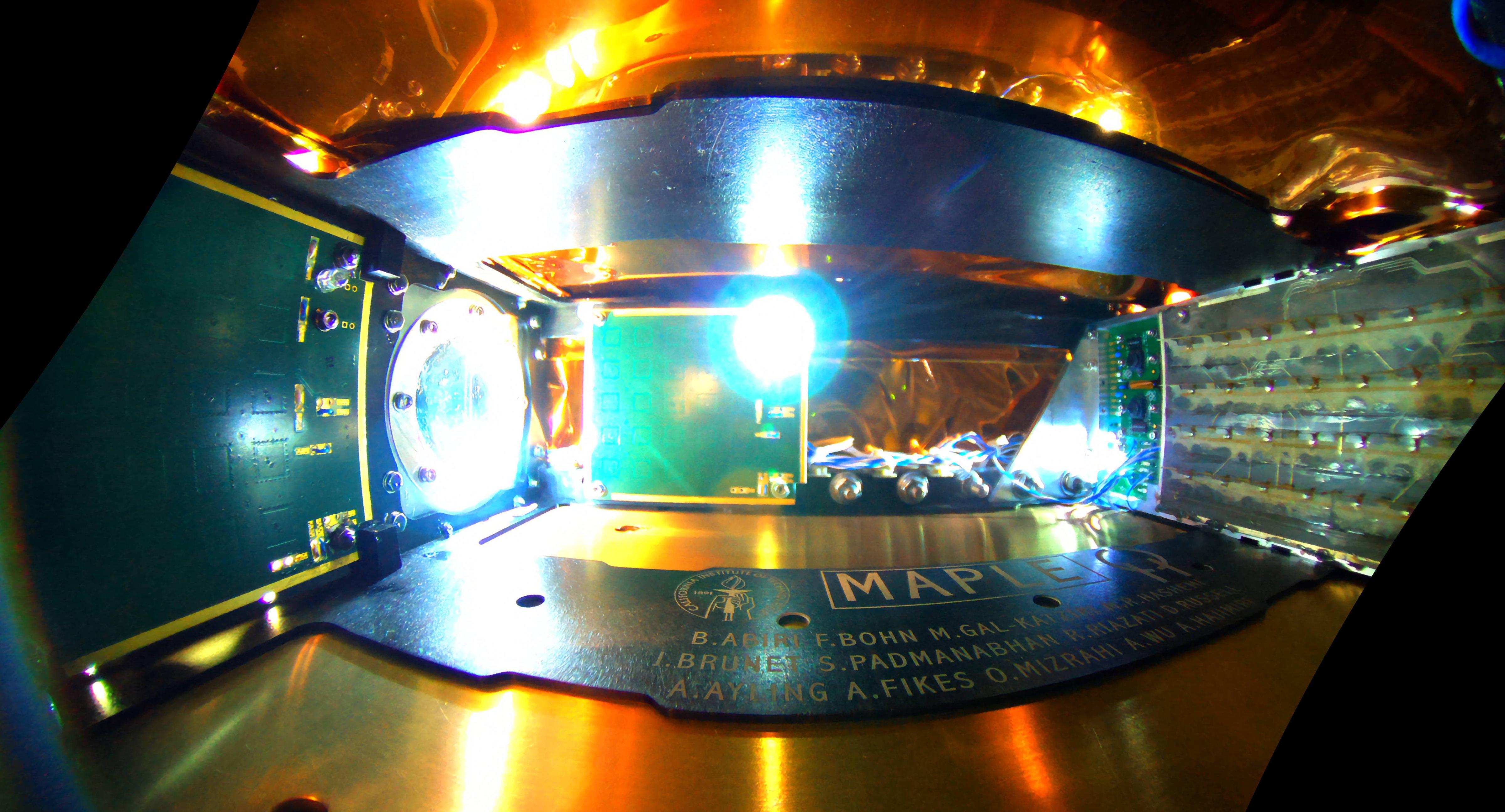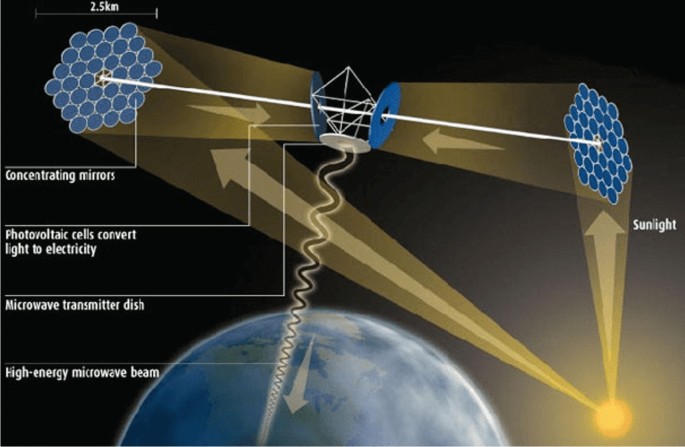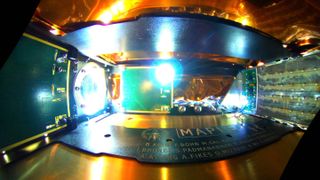In a First, The new results from last Monday’s experiment have proven that the technology could actually work from space.
The next step is to sort out small irregularities to improve the next generation of the power transmission system, a process that can take months. Then it’s on to the task of integrating all the experimental components into a bigger system. “While there are still hurdles to overcome for large scale wireless energy transfer of space solar,” says Hajimiri, “this gets us closer.” Wirelessly Transmits Power in Space

A space solar power prototype that was launched into orbit in January is operational and has demonstrated its ability to wirelessly transmit power in space and to beam detectable power to Earth for the first time.
Wireless power transfer was demonstrated on March 3 by MAPLE, one of three key technologies being tested by the Space Solar Power Demonstrator (SSPD-1), the first space-borne prototype from Caltech’s Space Solar Power Project (SSPP). SSPP aims to harvest solar power in space and transmit it to the Earth’s surface.
MAPLE, short for Microwave Array for Power-transfer Low-orbit Experiment and one of the three key experiments within SSPD-1, consists of an array of flexible lightweight microwave power transmitters driven by custom electronic chips that were built using low-cost silicon technologies. It uses the array of transmitters to beam the energy to desired locations. For SSPP to be feasible, energy transmission arrays will need to be lightweight to minimize the amount of fuel needed to send them to space, flexible so they can fold up into a package that can be transported in a rocket, and a low-cost technology overall.
MAPLE was developed by a Caltech team led by Ali Hajimiri, Bren Professor of Electrical Engineering and Medical Engineering and co-director of SSPP.
“Through the experiments we have run so far, we received confirmation that MAPLE can transmit power successfully to receivers in space,” Hajimiri says. “We have also been able to program the array to direct its energy toward Earth, which we detected here at Caltech. We had, of course, tested it on Earth, but now we know that it can survive the trip to space and operate there.”
Using constructive and destructive interference between individual transmitters, a bank of power transmitters is able to shift the focus and direction of the energy it beams out—without any moving parts. The transmitter array uses precise timing-control elements to dynamically focus the power selectively on the desired location using the coherent addition of electromagnetic waves. This enables the majority of the energy to be transmitted to the desired location and nowhere else.
MAPLE features two separate receiver arrays located about a foot away from the transmitter to receive the energy, convert it to direct current (DC) electricity, and use it to light up a pair of LEDs to demonstrate the full sequence of wireless energy transmission at a distance in space. MAPLE tested this in space by lighting up each LED individually and shifting back and forth between them. The experiment is not sealed, so it is subject to the harsh environment of space, including the wide temperature swings and solar radiation that will be faced one day by large-scale SSPP units.
“To the best of our knowledge, no one has ever demonstrated wireless energy transfer in space even with expensive rigid structures. We are doing it with flexible lightweight structures and with our own integrated circuits. This is a first,” says Hajimiri.
MAPLE also includes a small window through which the array can beam the energy. This transmitted energy was detected by a receiver on the roof of the Gordon and Betty Moore Laboratory of Engineering on Caltech’s campus in Pasadena on May 22. The received signal appeared at the expected time and frequency, and had the right frequency shift as predicted based on its travel from orbit.
Beyond a demonstration that the power transmitters could survive the launch (which took place on January 3) and space flight, and still function, the experiment has provided useful feedback to SSPP engineers. The power transmission antennas are clustered in groups of 16, each group driven by one entirely custom flexible integrated circuit chip, and Hajimiri’s team now is assessing the performance of individual elements within the system by evaluating the interference patterns of smaller groups and measuring difference between various combinations. The painstaking process—which can take up to six months to fully complete—will allow the team to sort out irregularities and trace them back to individual units, providing insight for the next generation of the system.
Space solar power provides a way to tap into the practically unlimited supply of solar energy in outer space, where the energy is constantly available without being subjected to the cycles of day and night, seasons, and cloud cover—potentially yielding eight times more power than solar panels at any location on Earth’s surface. When fully realized, SSPP will deploy a constellation of modular spacecraft that collect sunlight, transform it into electricity, then convert it to microwaves that will be transmitted wirelessly over long distances to wherever it is needed—including locations that currently have no access to reliable power.
“The flexible power transmission arrays are essential to the current design of Caltech’s vision for a constellation of sail-like solar panels that unfurl once they reach orbit,” says Sergio Pellegrino, Joyce and Kent Kresa Professor of Aerospace and Civil Engineering and co-director of SSPP.
“In the same way that the internet democratized access to information, we hope that wireless energy transfer democratizes access to energy,” Hajimiri says. “No energy transmission infrastructure will be needed on the ground to receive this power. That means we can send energy to remote regions and areas devastated by war or natural disaster.”
SSPP got its start in 2011 after philanthropist Donald Bren, chairman of Irvine Company and a lifetime member of the Caltech Board of Trustees, first learned about the potential for space-based solar energy manufacturing as a young man in an article in the magazine Popular Science. Intrigued by the potential for space solar power, in 2011, Bren approached Caltech’s then-president Jean-Lou Chameau to discuss the creation of a space-based solar power research project. In the years to follow, Bren and his wife, Brigitte Bren, also a Caltech trustee, agreed to make the donation to fund the project. The first of the donations to Caltech (which will eventually exceed $100 million in support for the project and endowed professorships) was made through the Donald Bren Foundation.
“The hard work and dedication of the brilliant scientists at Caltech have advanced our dream of providing the world with abundant, reliable and affordable power for the benefit of all humankind,” Bren says.
“The transition to renewable energy, critical for the world’s future, is limited today by energy storage and transmission challenges. Beaming solar power from space is an elegant solution that has moved one step closer to realization due to the generosity and foresight of the Brens,” says Caltech President Thomas F. Rosenbaum. “Donald Bren has presented a formidable technical challenge that promises a remarkable payoff for humanity: a world powered by uninterruptible renewable energy.”
In addition to the support received from the Brens, Northrop Grumman Corporation also provided Caltech $12.5 million over three years through a sponsored research agreement between 2014 and 2017 that supported for the development of technology and advancement of science for the project.
“Demonstration of wireless power transfer in space using lightweight structures is an important step toward space solar power and broad access to it globally,” says Harry Atwater, Otis Booth Leadership Chair of Division of Engineering and Applied Science; Howard Hughes Professor of Applied Physics and Materials Science; Director of the Liquid Sunlight Alliance; and one of the principal investigators of the project. “Solar panels already are used in space to power the International Space Station, for example, but to launch and deploy large enough arrays to provide power to Earth, SSPP has to design and create solar power energy transfer systems that are ultra-lightweight, cheap, and flexible.”
Individual SSPP units will fold up into packages about 1 cubic meter in volume and then unfurl into flat squares about 50 meters per side, with solar cells on one side facing toward the sun and wireless power transmitters on the other side facing toward Earth.
A Momentus Vigoride spacecraft launched aboard a SpaceX rocket on the Transporter-6 mission carried 50-kilogram SSPD to space. Momentus is providing ongoing hosted payload support to Caltech, including providing data, communication, commanding and telemetry, and resources for optimal picture taking and solar cell lighting. The entire set of three prototypes within the SSPD was envisioned, designed, built, and tested by a team of about 35 individuals—faculty, postdocs, graduate students, and undergrads—in labs at Caltech.
SSPD has two main experiments besides MAPLE: DOLCE (Deployable on-Orbit ultraLight Composite Experiment), a structure measuring 6 feet by 6 feet that demonstrates the architecture, packaging scheme, and deployment mechanisms of the modular spacecraft; and ALBA, a collection of 32 different types of photovoltaic cells to enable an assessment of the types of cells that are the most effective in the punishing environment of space. The ALBA tests of solar cells are ongoing, and the SSPP has not yet attempted to deploy DOLCE as of press time. Results from those experiments are expected in the coming months. source
read when it first launched:
Caltech to Launch Space Solar Power Technology Demo into Orbit in January
Satellite beams solar power down to Earth, in first-of-a-kind demonstration
Experiment brings credibility to idea of space-based energy
 Researchers at the California Institute of Technology detected tiny amounts of microwave power beamed from space.ALI HAJIMIRI/CALIFORNIA INSTITUTE OF TECHNOLOGY
Researchers at the California Institute of Technology detected tiny amounts of microwave power beamed from space.ALI HAJIMIRI/CALIFORNIA INSTITUTE OF TECHNOLOGY
Researchers have taken a small but necessary step toward realizing a long-standing dream: harvesting solar energy in space and beaming it down to Earth. A satellite launched in January has steered power in a microwave beam onto targets in space, and even sent some of that power to a detector on Earth, the experiment’s builder, the California Institute of Technology (Caltech), announced on 1 June. “No one has done this before,” says space scientist Sanjay Vijendran at the European Space Agency (ESA). “They’re bringing credibility to the topic by demonstrating this capability.”
Credibility has long been the challenge for space-based solar power. To produce as much power as a typical coal or nuclear power station, a satellite would need a collecting area kilometers across, requiring hundreds of launches and assembly in orbit. NASA planned a demonstration mission during the 1970s energy crisis. But with the technology of the time, carried aloft by the Space Shuttle and assembled by astronauts, the mission would have cost $1 trillion. Few took it seriously after that.
Space has changed since then. Solar cells and microwave beams are cheaper and more efficient. Robots capable of assembling structures will soon be in orbit, and companies such as SpaceX have slashed the cost of launches. Recent studies commissioned by ESA and the U.K. government suggest giant orbiting generators will soon be able to generate electricity at costs comparable to earthbound nuclear plants.
A few scattered research programs have nudged the field forward. Starting in the 1980s, researchers at Kyoto University demonstrated power beaming over short distances at the edge of space using suborbital rockets. In 2020, a team from the U.S. Naval Research Laboratory sent a pizza box–size “sandwich panel” into orbit with solar cells on one side, a filling of electronics, and microwave transmitters on the other side to demonstrate sunlight-to-microwave conversion.
The Caltech mission, funded by the Donald Bren Foundation and Northrop Grumman Corporation, aimed to go a step further with lightweight, inexpensive, and flexible components. The microwave transmitter was an array of 32 flat antennas packed onto a surface slightly larger than a dinner plate. By varying the timing of signals sent to the different antennas, the researchers could steer the array’s beam. They pointed it at a pair of microwave receivers about a forearm’s distance away and switched the beam from one receiver to the other at will, lighting up an LED on each.
The transmitted power was small, just 200 milliwatts, less than that of a cellphone camera light. But the team was still able to steer the beam toward Earth and detect it with a receiver at Caltech. “It was a proof of concept,” says Caltech electrical engineer Ali Hajimiri. “It indicates what an overall system can do.”
The Caltech spacecraft still has two more planned experiments. One is now testing 32 different varieties of solar cell to see which best survives the rigors of space. The second is a folded piece of ultralight composite material that will unfurl into a sail-like structure 2 meters across. Although the sail will not hold any solar cells, it is meant to test the kind of thin, flexible, and large deployments required for a future power station.
Interest in space-based solar power seems to be gathering momentum. ESA this year commissioned two studies into potential architectures for orbiting power stations. Vijendran says energy supply companies have joined the effort. The Kyoto team announced last month it would work with the Japanese space agency JAXA to test power beaming in orbit.
Kyoto electrical engineer Naoki Shinohara says he was pleased to hear of Caltech’s success, “but simultaneously I am disappointed because we, the Japanese, aimed to carry out the world’s first [wireless power transmission] satellite experiment in 2025.”
The startup company Virtus Solis Technologies has also been testing power beaming and plans to launch a pilot plant into orbit in 2026. CEO John Bucknell says the company intends to offer commercial power to customers before the end of the decade. “Space solar is the only clean, firm, scalable energy technology [with] a credible path to actual zero carbon emissions.” source
Scientists beam solar power to Earth from space for 1st time ever
SSPD-1 scientists work to detect power from MAPLE on the roof of Moore Laboratory at Caltech in California. (Image credit: Ali Hajimiri/Calech)
The instrument then beamed energy from a tiny window installed in the unit to the roof of Gordon and Betty Moore Laboratory of Engineering on Caltech’s campus in Pasadena.
Because MAPLE is not sealed, the experiment also demonstrated its capability to function in the harsh environment of space while subject to large swings in temperature and exposure to solar radiation. The conditions experienced by this prototype will soon be felt by large-scale SSPP units.
“To the best of our knowledge, no one has ever demonstrated wireless energy transfer in space, even with expensive rigid structures,” Hajimiri added. “We are doing it with flexible, lightweight structures and with our own integrated circuits. This is a first!”

In a video from Caltech above, Hajimiri, who led the Caltech that developed MAPLE, explained how the wireless transmission of energy through space is based on a quantum phenomenon called “interference.”
Interference arises due to the wave-like nature of light. When two light waves overlap, if they are in phase, the waves align, and the peaks of the waves meet and create a greater peak with a height that is the sum of the two original peaks. This is called constructive interference.
If, however, the waves of light are out of phase and overlap while misaligned, a peak may meet a trough in the wave, and both are canceled out, a process known as destructive interference.
“If you have multiple sources that are operating in concert, in the same phase, you can actually direct energy in one direction so all of them will only add in one direction and will cancel each other out in all other directions,” Hajimiri said. “The same way that a magnifying glass can focus light into a small point, you can actually control the timing of this in such a way that you can focus all of that energy in a smaller area than the area that you started with.”
By precisely controlling the timing of this process, the direction of the energy can be adjusted very rapidly on a scale of nanoseconds, and power can be redirected to space-based receivers or even receivers here on Earth. Together this allows the energy to be directed to the desired location and nowhere else, and all this can be done without the need for any moving mechanical parts.
Hajimiri and his team are now assessing the performance of the individual units that comprise MAPLE. a painstaking process that will take as long as six months to complete. This will allow them to provide feedback that will guide the development of fully realized versions of the system in the future.
It is planned that SSPP will eventually consist of a constellation of modular spacecraft collecting sunlight, transforming it into electricity, and turning this into microwaves that are then beamed over vast distances, including back to Earth, where energy is needed. This could include regions of the globe currently poorly served by existing energy infrastructure.
“In the same way that the internet democratized access to information, we hope that wireless energy transfer democratizes access to energy,” Hajimiri concluded. “No energy transmission infrastructure will be needed on the ground to receive this power. That means we can send energy to remote regions and areas devastated by war or natural disaster.” source
Scientists Just Got A Step Closer to The Sci-Fi Reality of Building Solar Power Stations in Space
On the night of May 22, a group of researchers and students gathered around a computer monitor on the roof of Caltech’s electrical engineering department. The monitors were connected to equipment designed to detect microwave radiation received from a satellite in space. And about 300 miles above them, far over the night’s thick cover of clouds, that satellite was about to pass overhead, equipped as a test bed for technologies they had developed to gather solar energy in space and project it down to Earth.
The researchers weren’t expecting much. They had already accomplished their primary objective back in March: using microwave radiation to project electricity across a gap of a few inches to light up a pair of LEDs onboard the spacecraft to test whether their power transfer system, essential for one day getting solar power down to Earth, would hold up in the harsh environment of space. There was a lot of uncertainty over whether they could get a tiny quantity of measurable power down to Earth on their first try. Still, they grew quiet as the time of the satellite pass overhead grew nearer. At 9:57 p.m., the monitors began showing the background radiation the receivers were picking up coalescing into something else: an electrical signal that matched what was being projected by their satellite. They had successfully detected the microwave energy that their novel power transfer system was directing toward Earth. “It took it a few moments to sink in,” says Ali Hajimiri, a professor of electrical engineering at Caltech. “Then everyone got really excited.”
Hajimiri leads a component of a larger endeavor by Caltech researchers to develop technology that could gather the sun’s energy in massive satellites orbiting Earth and beam it down to power the grid. It’s an audacious concept, with world-changing benefits should such orbiting solar power plants ever be built. Solar panels on Earth only work during the day, and they don’t produce much power on cloudy days or when the sun is low in the evening or early morning. In orbit, however, such panels would produce a constant stream of zero-emission power. “In space, it’s always noon on a sunny day,” says Hajimiri.
It’s an idea that has captured the imagination of writers and futurists for decades—the first published mention of the concept likely came in a 1941 short story by I, Robot writer Issac Asimov. But even as communication satellites, moon landings, and probes to Mars became reality, solar power stations remained in the realm of science fiction. Many components necessary for such a system were developed through the years, but the physical problems of getting that theoretical power station off the ground were more difficult—any system capable of generating a useful quantity of electricity would be far too heavy to feisably heft into orbit.
But researchers on Caltech’s Space Solar Power Project say that new technological developments—particularly the potential for extremely light, flexible solar panels and lightweight energy transfer systems to replace bulky antennas—have brought the idea into the realm of reality. Caltech’s Space Solar Power Demonstrator, launched in January, includes an array of different types of advanced solar panels to test which will work best for a space solar power station, as well as a test system designed to unfold into a 6-by-6-ft. structure that could be used to hold solar panels, alongside Hajimiri’s energy transfer system.
Caltech isn’t the only organization that has become interested in solar power stations. The Chinese government is planning a 2028 mission to demonstrate the technology in low Earth orbit. And last November, science ministers in the E.U. greenlit Solaris, a joint project between the European Space Agency (ESA) and aerospace company Airbus to look into the possibility of building gigantic solar power stations in geostationary orbit over Europe. (Whether intentional or not, the linkage to the world of mid-century sci-fi remains, with the project sharing the title of Stanislaw Lem’s classic 1961 novel.)
Caltech’s Space Solar Power Demonstrator isn’t actually a prototype power station. Rather, it’s a collection of three separate experiments to test components that would eventually be integrated into one system. Two of the experiments—the self-assembly system and the solar tests—haven’t produced results yet. The energy transfer component worked in sending electricity a few inches. When directed towards Earth, it spread most of its power output over a very wide area, as expected, only managing to get an extremely tiny fraction of its energy onto the receiver (a larger system could focus the energy onto a much smaller area). In a fundamental sense, the way that system works is no different from the typical way that satellites communicate with Earth by projecting microwave radiation that gets converted into electrical energy at a receiver. But Hajimiri’s system is designed differently, based on a concept that would allow it to scale up to focus large amounts of power onto small Earth-based receivers. With more funding and research, the engineers working on the project are optimistic that the technology could reach commercialization in the decades ahead. In about five years, they think they might be able to build a system that could transfer enough solar power to charge a laptop from space. From there, it’s a matter of scaling up further to build a full-fledged commercial power station.
“We are currently building things in our university labs, and so we are necessarily small in scale,” says Sergio Pellegrino, a Caltech professor of aerospace and civil engineering working on the space solar project. “This infrastructure is going to be very large, so a transition to an industrial production facility is key to the next step.
“It takes a few years, with the right amount of money,” he adds. “It doesn’t take very many years.”
The researchers at Caltech came to be in the same league as the Chinese government and the ESA thanks to the interest of one man. In 2011, Donald Bren, 91, a billionaire California real estate magnate and lifetime member of Caltech’s board of trustees, read a Popular Science article about space-based solar power. Intrigued by the potential of the technology, he began funding a program at Caltech to pursue the idea, eventually contributing more than $100 million dollars.
Three Caltech professors came on board. Pellegrino researched lightweight, self-assembling structures—something that could fit in a small space in a rocket, but then unfold in orbit to absorb the sun’s rays. Harry Atwater, a professor of applied physics and materials science, looked into finding the right solar panels for the power station. Traditional solar arrays on satellites use glass to protect underlying systems, but such a solution would be too heavy for the solar power station. “We’ve been investigating how we can make things intrinsically radiation hard, and therefore we could get rid of that piece of glass,” Atwater says.
Hajimiri, meanwhile, headed up the portion of the project investigating energy transfer. Over video chat, he shows his solution, a flexible sheet covered with a grid pattern. Rather than pointing a single huge antenna at a target, each point on Hajimiri’s grid system emits a small amount of microwave radiation. Computers minutely adjust the frequencies of the overlapping radiation, creating a kind of lensing effect using constructive and destructive interference, like overlapping ripples in a pond, to focus the energy on a particular point. “You’ve gone from a giant elephant to an army of ants of these individual transmitters,” says Hajimiri.

A power station using such technology could send electricity to any point below it on Earth, could switch transfer locations almost instantly, or even direct energy to multiple locations at once. It opens up the possibility of easily sending power to places around the world that need it most, or directing power to specific locations after natural disasters. All first responders would have to do is unroll a receiver on the ground to receive a steady supply of electricity, even on cloudy days or at night.
The new results from last Monday’s experiment have proven that the technology could actually work from space. The next step is to sort out small irregularities to improve the next generation of the power transmission system, a process that can take months. Then it’s on to the task of integrating all the experimental components into a bigger system. “While there are still hurdles to overcome for large scale wireless energy transfer of space solar,” says Hajimiri, “this gets us closer.”





